Wise men said : “Choose Your Battle Carefully”. It can’t be less true when it comes to plant. In this article, the horticulture expert, Riya Maji, brings you 8 best plants for the house that you can’t miss in your gardening journey.

Thinking about getting your first plants for the house? But which one? Don’t worry it’s normal to get confused as there’s a vast range and habits of house plants to pick from.
To clear up your confusion we will be talking about the eight best plants for the house that will fit your unique needs.
The plants we will be sharing are recommended by the experts in our nursery. They not only shared their favorites but also shared what distinctive purpose they serve.
As they say “If the glove fits it becomes much easier to care for them”. Let’s discuss their top picks so you can effortlessly choose from the list.
Best easy-to-care for indoor plant:
Peace lily:
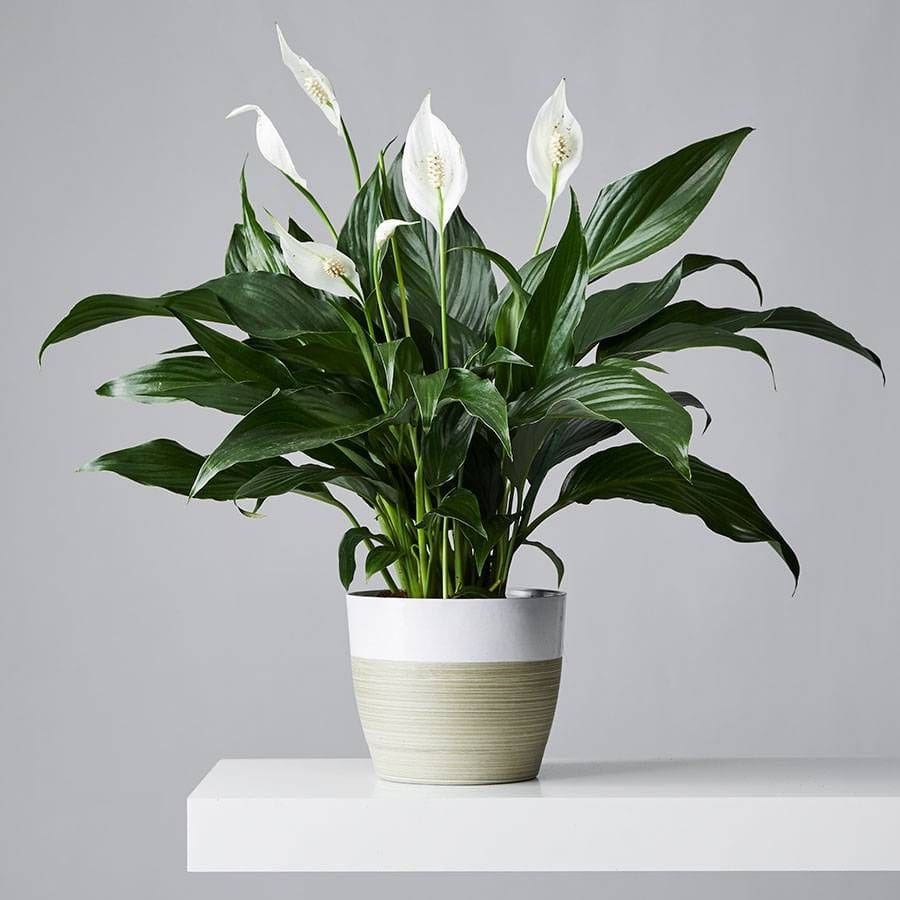
| Quick Facts | |
| Scientific Name | Spathiphyllum |
| Common Names | White sails, spathe flower |
| Most attractive Factors | The color combination of deep green and pure white. |
| Maintenance level | Easy |
| Symbolism | Purity, prosperity, and innocence |
| Display | Tabletop, selves, room corners. |
Peace lilies are sturdy, easily manageable plants with shiny, deep green oval leaves that have pointy tips. The leaves emerge straight from the soil. These plants also occasionally make lightly aromatic white flowers that look like calla lilies. The flower is long-lasting and turns green upon maturing.
Peace lilies are ideal to grow in the home and office. They are shade tolerant and easy to maintain at the same time it purifies indoor air quality too. Its striking green-and-white contrast will easily catch the eye. Peace lilies are also believed to bring good luck and fortune in any space you keep.
Peace lilies are shade-loving plants and when they are grown outdoors they are more vulnerable to direct sunlight. To provide ideal filtered sunlight, place them near an east-facing window. They grow well in regular well-draining potting mixed with organic matter. They can easily live through under-watering situations than over-watering, but never let the soil completely dry out. Their ideal temperature tolerance capacity is 65 to 80 degrees Fahrenheit.
And that made it the first best plants for the house. Interested? Click on the link below to check the details.
Best house plant for cleaning the air:
Boston fern:
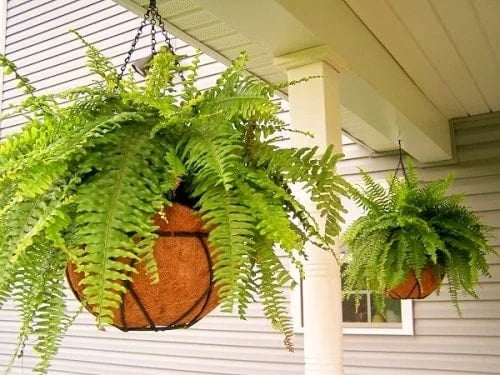
| Quick Facts | |
| Scientific Name | Nephrolepis exaltata |
| Common Names | Sword fern |
| Most attractive Factors | It’s sword-like leaves |
| Maintenance level | Easy to medium |
| Symbolization | Sincerity |
| Display | As a hanging basket plant. |
Boston ferns have wide fronds with alternating pinnae on both sides of the midline of the leaves. With maturation, the leaves turn medium to pale green and reach as broad as 6 inches. The fronds have two rows of round clusters and those spore-bearing organs known as sori around the margins underneath the leaves.
Boston Ferns can evolve nicely both in indoor and outdoor circumstances. Apart from improving aesthetics, they are furthermore helpful in removing toxic air contaminants from the environment. It also enhances humidity by assisting to revive moisture in the air naturally.
Boston fern is another plant that prefers indoor weather instead of outdoors. They thrive in warm and humid conditions. They don’t mind over and under water conditions but it’s better to not leave them in dry spells for days. If you are residing in a drier region you should mist the leaves from time to time. Boston ferns are all leaves and the longer the leaves the better the look it gives so pruning is not really needed. Only pests and diseases can affect these plant’s health, so if you notice infected leaves remove them immediately.
Best plant for the house with low light
ZZ plant

| Quick Facts | |
| Scientific Name | Zamioculcas |
| Common Names | Zuzu plant, Aroid Palm, Emerald Palm, and Eternity plant. |
| Most attractive Factors | Its deep green leaves go well with both modern and traditional interiors. |
| Maintenance level | Easy to maintain. |
| Symbolization | Good fortune. |
| Display | As a centrepiece in your garden, office space, or living room. |
ZZ plants are widely known as flowering plants, but they very infrequently make flowers. Instead, the plant is famous for its broad, vibrant green leaves. They can be cultivated as desk plants or floor plants and can expand quite tall if left unbothered. The leaves can be as long as 60 centimetres.
The ZZ Plant is perfect for dimmer spots in your house. ZZ Plants will be absolutely okay in remarkably lower levels of sunlight. Or even spaces with no sunlight reach at all as they will bear fluorescent lighting as a replacement for natural sunlight.
Learn more about ZZ Plants Benefit
You can keep the ZZ plant alive with minimum care. They do best with an adequate amount of sunlight but they don’t mind staying indoors their whole life. You can water them once every two weeks but you also don’t have to feel guilty about your forgetful nature, as these plants store water in their roots to survive in these kinds of situations. An east-facing window in your house can be the ideal spot for them. The main problem they might face is the dust layering over the big shiny leaves. Wipe them out with a damp cloth to save them from clogging pores.
Snake plant is a no-nonsense plant.
and that makes it the best plant for the house. Let’s check it out.
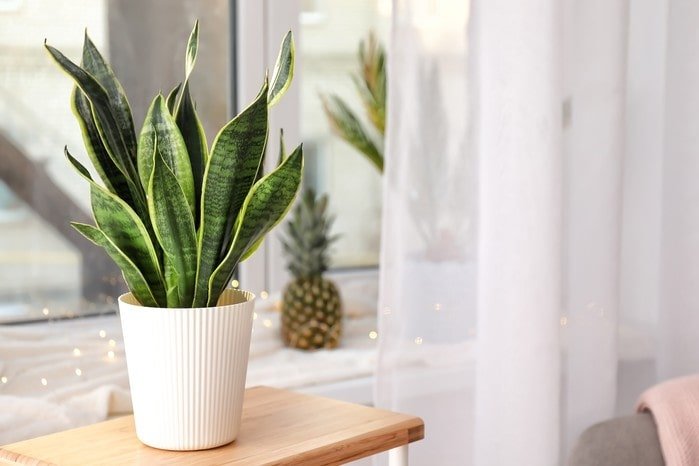
| Quick Facts | |
| Scientific Name | Dracaena trifasciata |
| Common Names | Saint George’s sword and mother-in-law’s tongue. |
| Most attractive Factors | Available in numerous shapes and variegations. |
| Maintenance level | Easy to care for. |
| Symbolization | Cleanliness and tenacity. |
| Display | They look great with white pots. |
Upright, fleshy, pointed, sword-like leaves are vibrant green with pale-green flat stripes. Leaves grow stiffly in a rosette from a wide rhizome. Tiny, aromatic, greenish-white blossoms bloom on established plants in spring, and the flowers produce orange berries.
Snake plants can thrive in dim areas of your home. They will cherish a spot with a sunny windowsill. But a space with literally no light reach will cause them quite hard to adjust for even the most shade-loving plants like snake plants, meaning they will survive but not happily. In that condition, you can support your plants by turning on artificial grow lights for a few hours per day.
Snake plants are known for their broad level of tolerance level. There are instances where people found these plants living inside a cupboard and bathroom. But I have noticed that they are not quite good with cold temperatures and they would love to be under-watered rather than over-watered. Their leaves exclusively store fluid to survive in harsh situations. In winter they can go up to two months without a single drop of water. You should look for the soil to get dry before giving them a drink.
Best plant for the front of your house:
Bird of Paradise:
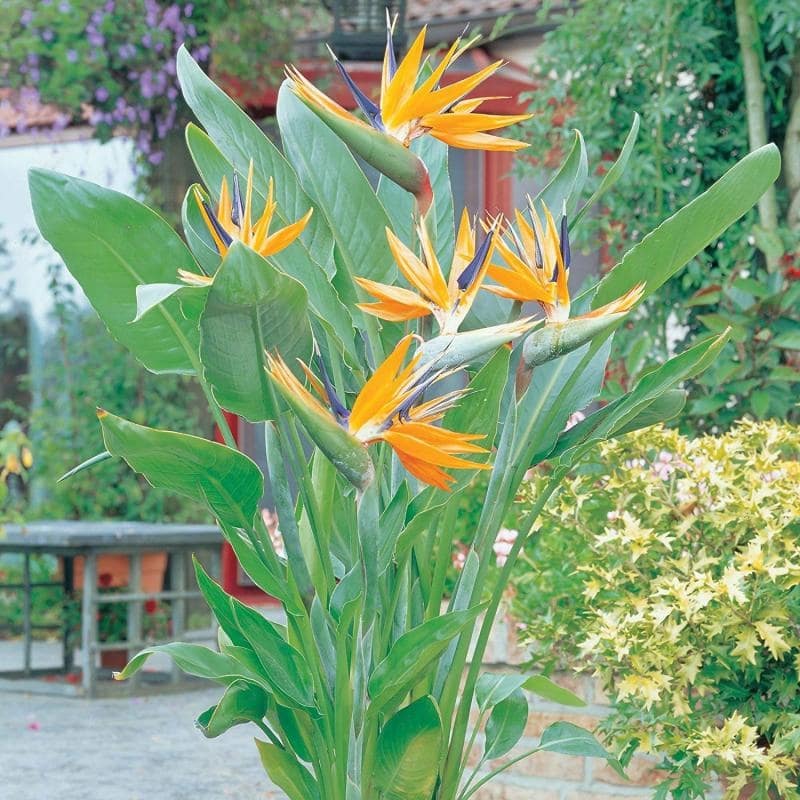
| Quick Facts | |
| Scientific Name | Strelitzia |
| Common Names | Crane flower and Isigude in Nguni. |
| Most attractive Factors | Striking yellow and blue coloured flowers look like birds. |
| Maintenance level | Easy to medium. |
| Symbolization | Freedom, anticipation, and joyfulness. |
| Display | Entrance of your house. |
It has rigid, upright, leathery, open, and oval leaves carried on a long leafstalk. The leaves are bluish-green in shade and have a red mid-line or midrib. The yellowish-orange and blue blossom has two upright pointy petals and five stamens. One primary flower bract, looks like a boat, is green, and has red borders on it.
Its beauty and striking colors create a strong first impression when someone enters your home. If you care for it properly they will put on a spectacular show upon blooming. Place them on both sides of the front door for best effect.
Even though we are suggesting this plant to keep semi-outdoors, they can be grown inside as well. And, that’s why we recommend it as the best plant for the house. But keep in mind, they grow more than 5 feet, so ideal for homes with spaces. Indoor plants will take more than three hours to produce their first flower. They prefer frequent watering, bright sunlight, and warmth. To boost their growth give them sunlight in warm summer days and keep them in indirect shaded sunlight in winter.
English ivy:

| Quick Facts | |
| Scientific Name | Hedera helix |
| Common Names | Common ivy and European ivy |
| Most attractive Factors | Deep green vines are naturally trailing for climbing. |
| Maintenance level | Require the least amount of effort to maintain. |
| Symbolization | Eternal life and fidelity. |
| Display | Use it as a hanging basket plant in your front yard. |
English ivy is a woody, evergreen, perennial vine usually can be found trailing outside your house or hedges. Vines are trailing or rising and can get over 90 feet long with stalks one foot broad. Most leaves are young—light green, lobed, with singular delicate veins—and multiply by creating roots at stalk nodes. Adult leaves are lustrous green and unlobed, propagating through sets of green flowers followed. English ivy weighs down trees, forcing them to fall. In a container, it will give a spilling-over-the-pot look.
English ivy excellently brightens up the entrance of your house and reflects your personality which is full of positivity. They require less care but still look amazing.
English ivy grows well in full shade to partial sunlight. That’s why they can be easily used as indoor hanging wall plants. They don’t care about the soil quality or pH levels as long as it drains well. Water the plant when the upper surface feels bone dry to the touch. Don’t let your English ivy stand in water for too long. The trailed-out stem can get heavy and drop from the basket, but you don’t have to worry about it, just pick it from the floor and insert it in the soil.
Best pet-friendly indoor plant:
Polka dot plant:
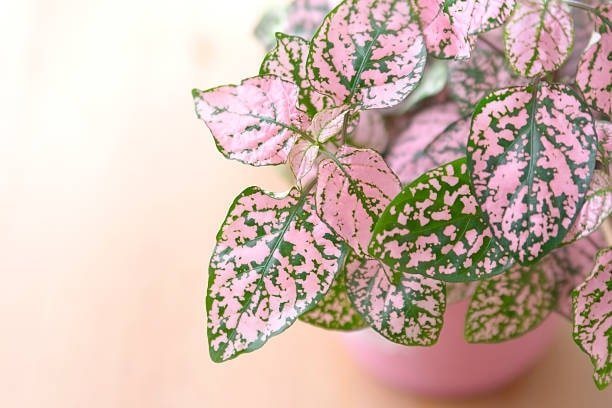
| Quick Facts | |
| Scientific Name | Hypoestes phyllostachya |
| Common Names | Flamingo plant, freckle face, and pink dot. |
| Most attractive Factors | Polka dot spots on the leaves. |
| Maintenance level | Easy to medium. |
| Symbolization | Joy and creativity. |
| Display | Use a white pot for the plant so the color contrast of the leaves stands out. |
The polka dot plant is a striking petite plant with lustrous variegated leaves that makes them distinctive from most other foliage. The most typical polka dot plants feature leaves with a light pink base shade and green flecks-like spots all over them. But there are many other dotted or mottled types with white, purple, and deeper red, those colors make the plant stand out even more. These plants are not particularly challenging to grow, but sometimes it’s hard to imitate their natural atmosphere.
Polka dot plants are not harmful to your curious cats and dogs. But if your pet consumes a piece of the plant, it may show signs like vomiting or diarrhea, which its gut uses to signify that you have consumed something that is not edible.
Polka dot plants should be potted in rich and quick-draining soil. You can keep those plants indoors where they can get partial sun to shade. Instead of pouring water out of need wait till the top half of the soil gets dry. Feed them in the growing season only. Polka dot only lives for one to two years. Indoor environments are more suitable for them so indoor polka dot plants last longer.
Best flowering indoor houseplant:
African violets:

| Quick Facts | |
| Scientific Name | Saintpaulia |
| Common Name | African violet. |
| Most attractive Factors | violet-like flowers bloom several times a year. |
| Maintenance level | Medium level care is required. |
| Symbolization | Faithfulness and devotion. |
| Display | Plant them in colorful pots and hang them near the window. |
The African violets are little perennial herbs with wide, fuzzy, ovate leaves. These deep green leaves have elongated stems and are organized in a cluster at the bottom of the plant. The violet-colored flowers are bilaterally symmetric with five petals and can vary in color like violet, white, or light pink. The little seeds are assembled in a capsule. The plants are effortlessly reproduced from leaf and branch cuttings.
African violets do well in filtered indirect sunlight. If you see the color fading gradually, indicating they are receiving too much sunlight and thin leaves indicate less sun exposure. Control water from contacting their leaves or it will result in brown spots. Clear dead and damaged flowers and leaves as soon as you notice them to boost wholesome growth. Frequently study the soil for extra moisture.
Conclusion:
While taking opinions from the experts we also created the list with minding some other factors. One of the main factors is availability, we made sure the plants are available across the country. Another important factor we kept in mind is the needs. The article is specified well with different needs like low light, pet safe, easy maintenance, air cleaner, etc. Hope all these factors together will help you pinpoint the particular plant you want.

